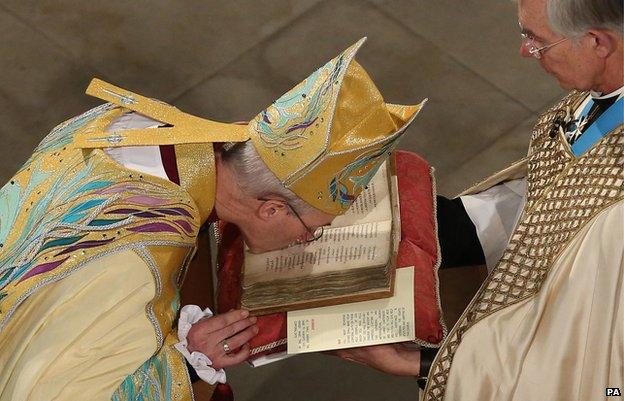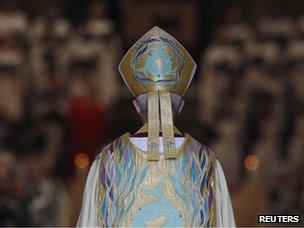Archbishop of Canterbury: 10 things about the enthronement
- Published

Justin Welby will be enthroned on Thursday as the 105th Archbishop of Canterbury at Canterbury Cathedral. Here are 10 lesser-known facts about the ceremony.
1. Why does he have to knock? By tradition, the new archbishop must knock three times on the door of Canterbury Cathedral to allow admittance. A young member of the congregation, Evangeline Kanagasooriam, will question him to find out who he is and why he has come. He will say: "I come knowing nothing except Jesus Christ and him crucified, and in weakness and fear and in much trembling."
2. What part do the royals play? Queen Elizabeth II is Supreme Governor of the Church of England. While Archbishop Welby waits outside, a mandate from the Queen will be read authorising his enthronement. The Prince of Wales will attend the enthronement.

Knocking three times
3. Why is there a Primate of England and a Primate of All England? The Archbishop of York, Dr John Sentamu, will play a key role in the ceremony, bidding Archbishop Welby to take the Declaration of Assent - his agreement to the doctrines of the Anglican Church. Dr Sentamu is styled Primate of England and the archbishop is Primate of all England. These confusing titles are believed to date from a papal ruling at the end of the 12th Century to settle the row over who is the superior of the two archbishops, granting superiority to Canterbury, but making York a primate too. A similar compromise was decided on for Ireland (between Armagh and Dublin) in the 14th Century.
4. What's the book he will kiss? The new archbishop will swear to observe the customs of Canterbury Cathedral on the Canterbury Gospels, said to have been brought to England by the first Archbishop, St Augustine, in 597.
5. Why two thrones? The archbishop will be enthroned on two different seats - first in the diocesan throne as bishop of Canterbury, then in the Chair of Augustine as Primate of All England. He will be enthroned by a woman - Archdeacon of Canterbury, the Venerable Sheila Watson - in the diocesan throne.
6. What's special about the Chair of St Augustine? It has been used for enthronements at least since the 13th Century. The archbishop will be seated in it by the Dean of Canterbury Cathedral, the Very Rev Robert Willis.
7. Anything notable about the guestlist? For once, organisers believe all the primates - heads of the provinces of the worldwide Anglican Communion - will attend the ceremony, a remarkable display of unity in a worldwide movement which is deeply riven by controversy, particularly over the appointment of gay priests and bishops by the Episcopalian Church in the United States. This has given rise to the near-breakaway Gafcon movement, whose current head is the Archbishop of Kenya Eliud Wabukala, while on the other side of the argument stands the head of the US Episcopal Church, Bishop Katharine Jefferts Schori.

Katharine Jefferts Schori and Eliud Wabukala
8. Why is he wearing second-hand robes? Archbishop Welby's vestments for the enthronement are a tribute to the late Bishop of Peterborough, Ian Cundy, who died aged 64 in 2009. These were bought as a gift for Bishop Cundy from the students and staff at Cranmer Hall, Durham. "During Bishop Ian's last three years in Durham, Justin Welby was one of his students," notes the Peterborough Telegraph, with photos of both men in the robes, external.

Symbolic of water and wine
9. What do the symbols on his robes mean? The vestments' design is based on the first miracle that Jesus did at the wedding in Cana - the blues and purples represent water changing into wine, as well as baptismal waters. The three golden fish on his mitre and on his robes suggest the Holy Trinity, while serving as a reminder to Christians to be partners in mission as fishers of men. The robes were designed and made by Juliet Hemingray.
10. Any significance to the date? Watch for mentions of Archbishop Welby's predecessor Thomas Cranmer - 21 March is the anniversary of his martyrdom during the reign of Queen "Bloody" Mary in 1556. He is revered as one of the chief spiritual inspirations of the Church of England and the originator of the Book of Common Prayer. It is also marked by the Church as the anniversary of the death of St Benedict.
You can follow the Magazine on Twitter, external and on Facebook, external
- Published12 March 2013